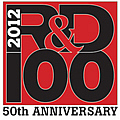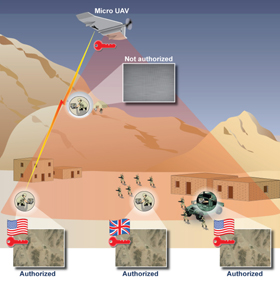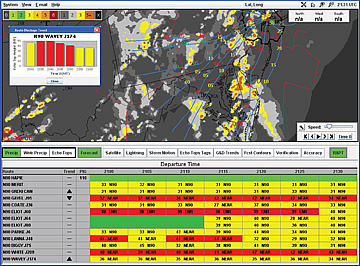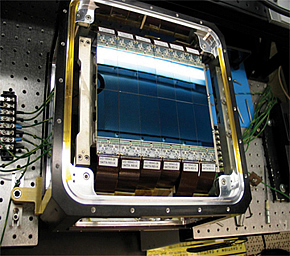News
Four innovative technologies garner 2012 R&D 100 Awards
for MIT Lincoln Laboratory
 MIT Lincoln Laboratory received four 2012 R&D 100 Awards for technologies developed for diverse applications: improving air traffic management, enabling wide-field-of-view optics, providing secure cryptographic key management, and increasing the power and brightness of industrial lasers used in welding and cutting.
MIT Lincoln Laboratory received four 2012 R&D 100 Awards for technologies developed for diverse applications: improving air traffic management, enabling wide-field-of-view optics, providing secure cryptographic key management, and increasing the power and brightness of industrial lasers used in welding and cutting.
R&D Magazine, an international journal for research scientists and engineers, annually presents the awards to recognize the 100 most technologically significant innovations introduced during the previous year. This year marks the 50th anniversary of the R&D 100 Awards. Recipients are chosen from hundreds of nominations by a panel of independent evaluators and the editors of R&D Magazine. Winners represent a broad range of technologies developed by industries, government laboratories, and university research facilities.
The 2012 R&D 100 Award recipients from Lincoln Laboratory are
- Lincoln Open Cryptographic Key Management Architecture—a highly portable software library that enables cryptographic protection for communication devices
- Route Availability Planning Tool—an automated decision support tool that predicts the availability of air traffic routes during thunderstorms
- Wavelength Beam-Combining Fiber-Coupled Diode Laser—a high-intensity diode laser that combines unprecedented brightness, efficiency, and reliability
- Wide Field-of-View Curved Focal Plane Array—a curved, charge-coupled device that corrects for inherent aberrations of the mirrors and lenses in optical systems
Solving the cryptographic key management problem
The Lincoln Open Cryptographic Key Management Architecture (LOCKMA) is a highly portable software library that solves the complex problem of cryptographic key management, thereby enabling broad use of cryptographic protections in devices.
Modern cryptography offers a variety of encryption/decryption schemes for the protection of information "at rest" on devices and in transit among devices. Although many efficient and secure encryption solutions have been standardized, these solutions are not universally used or embedded in miniature devices/computer systems because of the lack of generic, easy-to-deploy, and easy-to-use key management solutions.
 The illustration shows how ground control operators (left side of image) use key management to authorize or terminate authorization to other ground terminals.
The illustration shows how ground control operators (left side of image) use key management to authorize or terminate authorization to other ground terminals. The LOCKMA solution to this problem is a comprehensive software library that attends to all aspects of key management, including creation, storage, and distribution of cryptographic keys, via a simple, intuitive programming interface. LOCKMA is not tied to specific applications, data types, or communication channels, and as such can be easily integrated into a variety of applications in order to secure communication channels, establish protected device groups, control access to data, secure storage and memory, and perform secure software updates.
"Armed with LOCKMA and a very basic understanding of digital security, a competent engineer should be able to avoid myriads of pitfalls that lead to compromised security of so many modern systems," says Dan Utin, a lead developer of LOCKMA. "Our work aims to clear the last hurdles on the path to having cryptographic data protections being ubiquitous in devices and applications around us."
LOCKMA was designed for use with small tactical devices used by the Department of Defense and is currently being integrated into a small digital radio for miniature unmanned aerial vehicles. In the future, LOCKMA may be integrated in a variety of commercial devices to protect data both at rest and in transit.
LOCKMA was developed by a team from the Laboratory's Communication Systems and Cyber Security Division that included technical staff members Roger Khazan, Dan Utin, Adam Petcher, Jonathan Herzog, Sean O’Melia, and Robert Cunningham; contractors Walter Bastow and Raymond Govotski; and former contractor Mark Yeager.
Alleviating aircraft departure delays
The Route Availability Planning Tool (RAPT) provides air traffic managers with automated, current, reliable route-availability information on a data-rich interface. RAPT was designed to help relieve the burden typically faced by air traffic managers, particularly during periods of thunderstorm activity: gathering weather information, mentally envisioning the repercussions of the weather data, rechecking for rapidly changing weather, and then deciding when to allow aircraft to depart. Often during periods of disruptive weather, this decision-making process is so time-consuming, managers concentrate on landing the planes in the air and let the departures wait at their gates. The backlog of departures builds, arrivals get caught in the traffic jam, and airline schedules downstream of the affected airport are pushed out because planes are not reaching their destinations. The Federal Aviation Administration (FAA) estimates that ~42% of airport departure delays are caused by thunderstorm activity that disrupts the structured flight-routing. The congested airspace in the Northeast and Midwest United States is especially susceptible to long delays brought on by thunderstorms, and the effects of these delays ripple across the National Air Space.
RAPT, currently deployed at airports in the New York area and Chicago, significantly improves the management of departures. Its algorithms translate forecast data from the FAA’s Corridor Integrated Weather System into predictions of when airspace affected by thunderstorms will be passable. These predictions help air traffic managers determine when to close and reopen routes. Evaluations of the system have shown that RAPT helps reduce departure delays and airline costs associated with delays, for example, lost time, and increased fuel consumption during ground-holding of flights.
 The Route Availability Planning Tool (RAPT ) user-friendly display provides reliable route-availability information in the color-coded table in the lower section and continually updated weather-forecast information overlaid with departure routes in the map in the upper section. (Click image for larger view.)
The Route Availability Planning Tool (RAPT ) user-friendly display provides reliable route-availability information in the color-coded table in the lower section and continually updated weather-forecast information overlaid with departure routes in the map in the upper section. (Click image for larger view.)"The RAPT development team was very fortunate to have the opportunity to work with a very motivated, creative, and forward-looking group of operational personnel and managers at the Port Authority of New York/New Jersey and the FAA. The access to FAA facilities during operations; the ability to develop, field, and refine a prototype as we learned more about departure management; and the thoughtful suggestions of the users all contributed mightily to the success of the project," says Richard DeLaura, a lead investigator on the RAPT program.
The RAPT development team included Richard DeLaura, Ngaire Underhill, John Hayward, Kirk MacKenzie, and Bradley Crowe, technical staff members in the Homeland Protection and Air Traffic Control Division; Richard Ferris, technical specialist, and Russell Todd, subcontractor, of that division; Leo Prusak, Tom Kelly, and Ralph Tamburro of the FAA; Tom White, formerly of the FAA; and former Lincoln Laboratory staff members Michael Robinson, Nic Yaros, Shawn Allan, Dale Rhoda, and Beth Kocab. The team also received funding and support from the FAA Systems Operations program, and technical support for field evaluations from the FAA William J. Hughes Technical Center.
Improving industrial cutting and welding
The Wavelength Beam-Combining Fiber-Coupled Diode Laser is the first direct-diode laser that is bright enough to cut and weld metal. Diode lasers are the highest efficiency lasers, but until recently, their brightness has been relatively low compared to that of other kW-class lasers used in industrial applications. Lincoln Laboratory's fundamental breakthrough in wavelength beam-combining has enabled TeraDiode to develop a system that has the laser brightness necessary for industrial use. The TeraDiode laser is 10 times brighter than its diode-laser competitors.
 The wavelength beam-combining diode laser is shown cutting through several millimeters of steel. A small spot size combined with high intensity provides high-speed cuts through thick materials with minimal impairment to the width of the cut.
The wavelength beam-combining diode laser is shown cutting through several millimeters of steel. A small spot size combined with high intensity provides high-speed cuts through thick materials with minimal impairment to the width of the cut. The Laboratory's wavelength beam-combining (WBC) technology spatially merges multiple wavelength sources into a single, high-intensity beam with an order-of-magnitude improvement in brightness over the brightness achieved by a single source. The increase in beam intensity is linearly proportional to the number of sources. In addition, WBC increases the power of the output beam through its use of an array of lasers. The WBC technology may result in diode lasers—which are more efficient, inexpensive, reliable, and wavelength-versatile than CO2, fiber, and solid-state lasers—replacing other lasers for the most demanding material-processing applications.
"The beam from a diode laser, such as the one in your CD player, can be tightly focused to a very small spot—although with very small power. With wavelength beam combining, the power of many similar lasers, each at a different wavelength, can be overlapped to produce such a high-intensity spot that it can cut metal. The number of beams that can be made to overlap can be quite high by arranging for a small wavelength difference between them, just like you can achieve high spectral resolution with a spectrometer if you do things right. But I do not want to trivialize the task at hand; the optical engineering challenges have been difficult but very interesting," says Antonio Sanchez-Rubio, a principal developer of this technology.
The WBC Fiber-Coupled Diode Laser was developed by a team that included Antonio Sanchez-Rubio, Tso Yee Fan, Steven Augst, Kevin Creedon, and Anish Goyal, technical staff members in the Advanced Technology Division; Julie Gopinath and Vincenzo Daneu, former staff members; and Bien Chann and Robin Huang of TeraDiode and formerly of Lincoln Laboratory.
Enabling the next generation of deep-space surveillance
The Wide Field-of-View Curved Focal Plane Array, developed by Lincoln Laboratory, is a key enabling technology for the Defense Advanced Research Projects Agency's (DARPA) prototype of the next-generation, deep-space surveillance instrument, the Space Surveillance Telescope (SST). This focal plane array is a mosaic of curved charge-coupled devices (CCD) configured to match the inherent curvature of the high-power, sensitive optics of the SST. Lincoln Laboratory innovated a number of new manufacturing and metrology techniques to curve the silicon wafers of each CCD and precisely align them. The impetus for the design of these unique curved CCDs was to provide a focal plane that would enable low-noise, high dynamic range, uniform detections of the light gathered from deep-space objects by the SST.
 The wide field-of-view CCD in the integration test lab at Lincoln Laboratory. Note the curvature of the image of a fluorescent bulb at the top of the unit.
The wide field-of-view CCD in the integration test lab at Lincoln Laboratory. Note the curvature of the image of a fluorescent bulb at the top of the unit.The SST, once fully operational, is planned to be a crucial contributor to the U.S. Space Surveillance Network, which consists of several globally distributed radar systems and optical telescopes that locate and track space objects. Data from the SST are intended to enable estimates of satellite and debris orbits necessary to predict their positions and provide warnings for collisions and near passes. The SST provides a uniform, wide-field-of-view (FOV) survey of satellites orbiting the Earth thanks to the high-quality, sensitive snapshots provided by its wide FOV curved focal plane. By rapidly repeating this survey, SST is expected to afford scientists a new, rich source of data for building the high-precision orbits needed to mitigate future collisions and near misses as the number of deep-space payloads increases. "This focal plane array is a game-changing device for wide-area surveillance of Earth-orbiting space objects," says Ronak Shah, one of the principal researchers on the development this innovation.
Development of the Wide Field-of-View Curved Focal Plane Array led to advancements in processing techniques for individual imagers and precision metrology of imagers into a mosaic camera. These innovations have potential application in areas that require sensitive detections across large FOVs, such as remote sensing, surveillance, and medical imaging.
The multidisciplinary team from the Aerospace, Advanced Technology, and Engineering Divisions responsible for development of this focal plane array included Eric Pearce, James Gregory, Barry Burke, Harry Clark, Bradley Felton, David Fischi, Keith Warner, Richard Lambour, Ronak Shah, Edward Boughan, Donald Johnson, James Sopchak, and Anthony Smith. Gerald Luppino of GL Scientific and former employees Linda Mendenhall and Richard Osgood were also part of the team.
Past awards
Lincoln Laboratory has had a number of technologies recognized by R&D 100 Awards over the past two decades. In 2011, the Laboratory received awards for the Airborne Ladar Imaging Research Testbed (ALIRT), Multifunction Phased Array Radar Panel, Parallel Vector Tile Optimizing Library, and Pathogen Analyzer for Threatening Environmental Releases (PANTHER) Bioaerosol Identification System. The Digital-Pixel Focal Plane Array, Geiger-Mode Avalanche Photodiode Detector Focal Plane Array, Miniaturized RF Four-Channel Receiver, Runway Status Light System, and Superconducting Nanowire Single-Photon Detector were award winners in 2010. The Laboratory received an R&D 100 Award in 1998 jointly with Cyra Technologies and the Los Alamos National Laboratory for the Cyrax Portable, 3D Laser-Mapping and Imaging System, and a 1995 award was presented to the Laboratory for the GPS-squitter technology, a technique that uses GPS position data for automatic dependent surveillance of aircraft.
On 1 November 2012, this year's R&D 100 Awards will be presented to recipients at a banquet at the Renaissance Orlando Hotel in Orlando, Florida.
Posted July 2012
top of page